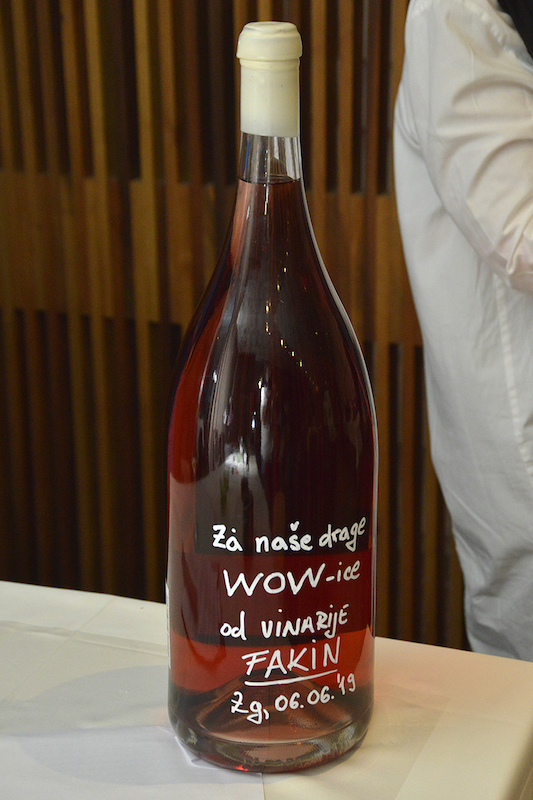Government Assistance to Croatian Winemakers Needs Prompt Realisation
As Marija Brnic/Poslovni Dnevnik writes on the 25th of June, 2020, a package of measures for Croatian winemakers was adopted which will allocate 38.5 million kuna for wine distillation and 5 million kuna for crisis storage.
On the exact day when new data on the number of people infected with the new coronavirus in Croatia were published, Croatian winemakers finally received a bit of very welcome good news from the Government that a package of intervention measures to mitigate the negative consequences of the pandemic on wine sales was accepted.
The measures regard the conversion of the existing multi-year national programme to help the wine sector, which will, as stated, allocate 38.5 million kuna for crisis distillation of wine, and 5 million kuna for the crisis storage of wine.
For the wine sold and delivered to the approved distiller, five kuna per litre of wine has been provided and a large number of Croatian winemakers/producers are interested in the costs of transporting wine to the distiller being reimbursed, and it is expected that several dozen producers will apply for this measure.
One of them is Josip Pavic from Erdut vineyards, who is also the president of the Wine Association of the Croatian Chamber of Commerce (HGK). "It won't save Croatian winemakers, when it's estimated that wine consumption will fall by 50 percent due to the coronavirus crisis, but it will ease the situation," said Pavic, adding that there isn't much of an alternative to be had because harvest time is coming and warehouses are full.
Similar measures are used by other countries across Europe, which, in addition to crisis distillation and storage, also apply a third solution, the so-called green harvest in vineyards, which we haven't considered in Croatia, but some Croatian winemakers, such as Vlado Krauthaker, carry it out themselves.
Green harvesting cuts costs
"This seems like a quality solution, because we'll reduce the yield to 50 percent earlier and we'll have fewer grapes, we'll reduce the cost of production, but in turn we'll raise the quality of wine," explained the famous winemaker, adding that it's difficult to estimate losses this year.
Dino Galic from Kutjevo says that the winery will apply for both measures, more precisely for storage of about 100 to 200 thousand litres for Kutjevo, and that their Đakovo wines (between 200 and 300 thousand litres) will apply for crisis distillation.
"We also proposed that the Government, in these extraordinary conditions, help Croatian winemakers with subsidised purchases. Such measures would preserve current liquidity, which will be quickly jeopardised,'' says Galic, adding that this package won't save producers, but any help is welcome. Most Croatian winemakers sell their products here on the domestic market, but due to the uncertain tourist season, the placement of wine is still "hanging in the air", and the situation is no better on foreign markets either.
The problem, as Krauthaker explains, is in the hyperproduction of wine on a global level, and Croatia is not recognised on the world wine list. At the moment, even strong winemakers from countries like France are devising plans to mitigate the losses of this sector.
Krauthaker says the solution is for manufacturers to start connecting and acting together promoting their region, in order to gain recognition, and they will have to invest more in that.
Most Croatian winemakers used measures to preserve jobs during the crisis, and didn't need to lay off workers, and in addition to this particular package of measures, Minister of Agriculture Marija Vuckovic announced possible further measures to help yesterday, but she didn't specify what they could be.
As the parliamentary elections draw closer, the most important thing for Croatian winemakers is to start implementing the measures just adopted as soon as possible. Yesterday, the Vice President of the Croatian Chamber of Commerce for Agriculture and Tourism, Dragan Kovacevic, appealed to the Ministry of Agriculture and especially to the Agency for Payments in Agriculture to start implementing these measures urgently, so that winemakers could receive support as soon as possible.
"We expect an urgent announcement of the tender for the implementation of these measures, so that due to the deadlines, they wouldn't jeopardise the realisation of the secured funds, especially for the crisis storage measure.
The members of the Croatian Chamber of Commerce Wine Association are therefore looking for a quick reaction and a simple tender procedure, without unnecessary administration,'' stated Dragan Kovacevic.
For more, follow our business page.
Premiere Tasting of Young Škrlet Wines at Zagreb Advent
Unique opportunity to taste nine young Škrlet wines in one place: Advent evening organized by the Moslavina Škrlet Association.
The foremost Škrlet producers of Moslavina region will premiere their 2019 harvest Škrlet wines to wine lovers at the Forum Gallery in Teslina 16, on Friday, 6th of December, 2019, from 17 to 22h.
Five medals from the recent Decanter awards for Škrlet wines are proof this variety is claiming its deserved spot on the wine list of Croatia and the world, one out of 120 indigenous Croatian varieties.
Visitors will have the opportunity to be the first to taste 9 young Škrlet wines from the 2019 harvest, one of them produced jointly by the Association members.
The ticket price is 60 kuna, including wine tasting and meeting the winemakers. Visitors will also be able to purchase promotional materials with the Škrlet brand.
The entire event has been financially supported by Zagreb County.

Croatian Winemakers: ''Less Grapes, But Quality Unquestionable''
Some varieties have already been harvested and although Croatian growers are struggling with labour shortages, the harvest will be finished by the end of September in Istria, Slavonia, and down in Dalmatia...
As Poslovni Dnevnik/Marta Duic writes on the 29th of August, 2019, grape harvesting is about to begin in Croatia's prominent wine-growing regions, with some varieties having already been harvested in order to make quality domestic wine.
In most Croatian regions, the yield is lower than it was last year, but winemakers have made sure to state that the quality still remains top notch this year. Oenologist Nika Silić Maroević, in charge of everything that happens in the barrels of the Korta Katarina winery in Pelješac in the far south of Dalmatia, has emphasised that this year's harvest is the closest to that of a regular, normal year.
Although concerned about Croatia's very rainy June, problems with wild boar and hail, Silić Maroević concluded that a very good harvest is awaiting Croatian growers this year.
"This year, the deadlines are almost as good as in the book, which is the best, because the vines have passed their normal ripening period, so, we expect the full potential of our vineyards to be realised. The grape harvest for rosé is underway, and the harvesting for pošip is yet to come. In recent years, we have encountered problems with finding a workforce, since we're selectively picking and don't have a constant rhythm of harvesting, we're somehow managing it, but there is a problem,'' noted Silić Maroević.
At the famous Tomić winery on the island of Hvar, the harvest started at the end of August, and the expectations are very good so far.
"The first harvest is pošip, and right after that we'll continue with cabernet sauvignon from our ecological vineyards. The quality of the grapes is excellent so far, which is also reflected in the later start of harvesting. For later varieties, we'll only see the effects in the period from September the 15th to September the 30th, and it will depend on the amount of precipitation and their ripening," Tomić explained.
Harvesting in Međimurje is only expected from around September the 15th, but winemaker David Štampar pointed out that the grapes are in exceptional condition.
"This year, we're not storing the grapes for predicate wines, but only for classic and sparkling wines. So far, we've had no problems with the workforce, and I don't think we will in the future either, because people like to go to do the harvesting. This year was really challenging because of the weather, but we love this lifestyle precisely because of the challenges it brings, too. This year, we will get some top quality wines, which are extremely characteristic of our region,'' Štampar assured.
Martina Krauthaker Grgić from the Krauthaker Winery pointed out that this year, the flowering in Slavonia in Eastern Croatia started a little later on, so the harvest is expected to start in the first week of September.
"The grapes will be smaller since last year was unusually fertile. When it comes to certain varieties, we've had made sure to have less grapes to ensure better quality, and the health of the vineyard is good, so we expect a solid harvest. There are problems with the workforce, but we've successfully found the number of pickers we need. The bigger problem is finding pickers in the immediate area because when pickers arrive from distant places, it increases the cost of the harvesting itself,'' explained Krauthaker Grgić.
The Franković Winery in Istria began with this year's harvest, as it does every year, by collecting grapes for the Stella sparkling wine base.
"We pick three varieties of white wine, malvasia, chardonnay and sauvignon for that base, and we pick the amount we need for champagne while the rest is harvested a few days later," explained Josip Franković, noting that a lack of manpower will make grape harvesting difficult this year.
"We face this problem every year and it gets harder every year, but we manage to deal with it all somehow. In terms of what we had last year, these [from 2019] are quite similar in their quality and quantity, and we're really pleased," concluded Franković.
Make sure to follow our dedicated lifestyle page for much more. If you're a lover of Croatian wine, give Total Croatia Wine a follow for more information.
Why International Wine Experts are Heading to Dalmatian Islands
August 4, 2019 - The exciting indigenous grapes on Dalmatia's islands are attracting increasing international interest. Great piece by Kate Hawkings in The Buyer on a visit to Korcula.
When I moved to Hvar in 2003, I had no idea it was a wine island or that, in fact, I had bought a house in the Dalmatian wine capital, Jelsa. I carried on in innocent ignorance for about 7 years until I started researching for the first edition of my guidebook, Hvar: An Insider's Guide.
And then I became fascinated. Not only did Hvar have some excellent winemakers, but the grapes themselves made the Hvar wine story even more interesting. It is said that there are 130 indigenous varieties all over Croatia, and I had no idea that Hvar was so rich in them.
The most famous is Bogdanusa, literally a 'gift from God', but there is also Prc and Darnekusa. I want to say Kuc as well, although from memory this exists elsewhere under a different name.
And then the longer I stayed, the more I discovered, most notably with Jelsa winemaker Teo Huljic, who introduced me to the Mekuja grape (he is the only one to make a 100% Mekuja, just 600 bottles). The following year, he opened one of only 70 bottles of Palarusa, an almost forgotten grape that even some Hvar winemakers had never heard of. Kortolaska is another rare variety only found on Hvar.
The more I looked, the more impressed I became. the islands of Croatia seemed to excel in indigenous varieties - you can learn more about them in Indigenous Wine Varieties on Croatian Islands.
And international wine experts are taking an increasing interest. The most high-profile of these, of course, is Jo Ahearne MW, the first Master of Wine to make wine in Croatia, much of it from Hvar's indigenous varieties.
Jo was featured in a great in-depth piece largely set on Korcula by Kate Hawkins in The Buyer.
Read on to find out why the international wine community is getting excited.
Learn more about the wines of Croatia in the Total Croatia Wine guide.
WOW Awards Ceremony and 8th Birthday of Women on Wine Held in Zagreb
June 10, 2019 - Association WOW/Women on Wine, popular as „WOW-ice “, is a very active (and pretty large) group of around 200 women throughout Croatia that are involved in promoting wine. Some are wine professionals – sommeliers, oenologists or wine bar owners and others are just wine lovers or wine and lifestyle journalists just like their president and founder, journalist and editor Sanja Muzaferija. Their mission is to constantly encourage young wine producers, especially women, but also give credit and regularly award all wine producers who please their demanding and educated palates.

For eight consecutive years, they give out awards for the Croatian WOW wine of the year in five categories: sparkling, white, rosé, red and dessert wine. The whole process of choosing the best wines is somewhat humorously titled What Women Want and lasts for about two months. Designed by Muzaferija, the selection is everything but lightly taken. It consists of three different steps, the first one being a sort of nomination/pre-selection list. The author of the list is a different renowned Croatian sommelier every year and the duty was previously performed by esteemed sommeliers such as Karin Rupene-Perdec, Alena Stuparić, Siniša Lasan, Mario Meštrović, Roko Bekavac, Jelena Šimić Valentić, and Željko Bročilović Carlos- This time, sommelier Filip Savić was appointed for the job.
The initial selection list always holds 5 sparkling wines, ten whites, five rosés, ten reds, and five dessert/sweet wines. The whole story begins from the initial selection list and after all the members of WOW have had one month to vote by mail, they come up with 12 finalists. The third and final phase of the contest is a blind tasting by three women knowledgeable in wine matters. They are the ones who choose the WOW wine in every category and the one that is being awarded the WOW Grand Prix Wine of the year title – regardless of the colour, price or style of the wine. All five winning wines get a nice sculpture designed by famous designer collective GRUPA, but the main prize of this very well accepted and after 8 years, very well respected choice, is an attractive trip to one of the famous world wine regions, provided and powered by WOW.
So far, the winners travelled all over Europe: Gianfranco Kozlović to Bordeaux, Saša Senjković to Champagne, Moreno Coronica to Barcelona and Penedes, Luka Krajančić to Burgundy, Frano Milina Bire to Austria and the representative of Meneghetti winery took a trip to Tuscany. Last year’s winner, Alen Bibić, declined the trip due to previous engagements. The awards ceremony for the 8th WOW Grand Prix took place, traditionally, in the restaurant Balon in Zagreb. The final jury consisting, naturally, entirely of women, has gathered previously at Jadranka bistro and has spoken their final word. They were: well-known and esteemed sommelier Karin Rupena Perdec as the president of the jury; Ines Matić, sommelier and Doris Srpek of the famous wine shop and wine bar Bornstein.
The wines that made it to the finals are: Sparkling – Blanc de Noir, Peršurić and Pavel, Šember, and the winner is - Blanc de Noir, Peršurić.
White wines: Meneghetti White 2017, Meneghetti; Grimalda white 2015, Matošević and Škrlet 2017, Voštinić- Klasnić - and the winner is the Meneghetti White 2015. In rose wines, the finalists are the Rosella Poletti 2017, Poletti and Rose Galić 2017, Galić. The winner is Rosella Poletti 2017. Red wines: Fuga 2015, Dobravac winery; Santa Lucija red 2015; Kozlović winery and Il Primo 2015, Fakin winery. The winner is Il Primo, Fakin winery. Dessert wines in the finals: Muškat Momjanski, Prelac winery and Graševina izborna berba prosušenih bobica 2015, Krauthaker winery. And the winner is Graševina izborna berba prosušenih bobica 2015, Krauthaker. The overall winner and the WOW Grand Prix new owner is Marko Fakin of Motovun with his Il Primo red wine that instantly gained the star status, not only among women voters. The winner will visit the Hungarian wine region Villany in July. After the awards ceremony – the wine crowd stayed on to celebrate the 8th birthday of the WOW association together with the wine producers who proudly held their WOW „stars“/awards and the media.

Photos of the jury: Silvija Munda
Photos of the ceremony: Rene Karaman
To read more about lifestyle in Croatia, follow TCN's dedicated page.
Croatian Family Wine Businesses Even Attracting Americans
Plešivica is an oasis for lovers of traditional gastronomy and wine-making, a longtime favourite destination for many of Zagreb's residents, Plešivica is famous for its many vineyards, wineries, sparkling wines and traditional food. Several Croatian family wine stories are attracting attention even from across the Atlantic.
As Marta Duic/Poslovni Dnevnik writes on the 18th of January, 2019, the Šember Winery, located in the village of Donji Pavlovčani, is famous for its sparkling wines that have been produced in their vinery for years. Ivanka Šember, the wife of a winery owner who helps him run the family business, says their sparkling wines are produced from old varieties which grow only on Plešivica. They have an old vineyard with fifteen different old and almost forgotten varieties, to which winemaker Zdenko Šember gives his special attention. He inherited this vineyard from his late grandmother and has since turned it into a flourishing business.
This year, this Croatian family winery business also produced a variety of new wine sparkling wines, a white sparkling wine from a black pinot, a sparkling wine of the old varieties which were kept in clay pots originating from Georgia. The production of amphora wines deeply buried in the ground is an extremely old tradition over in Georgia, and today many Croatian winemakers use this method. This method of wine production makes each wine, including sparkling wine from the assortment of this winery, completely different in flavour when compared to others.
"My husband loves experiments, and some of them also get to see the market!" said Ivanka Šember. The Šember Winery is one of the few in the Republic of Croatia which manually produces its sparkling wines, each step done with their own hands and without any machines. As the Croatian family say themselves, everything has been made even easier since they obtained a new 320m cellar. In the construction of the cellar, which was co-funded through the National Wine Sector Support Program, this wine oriented Croatian family invested more than two million kuna, and their plans for this year are to further expand their vineyards by another three hectares.
"When it comes to our sparkling wines, our best sellers are rose, this year we have doubled our production, and we're currently producing 40,000 bottles. We're the first winery to have been producing sparkling wines from old Plešivica varieties, explained Ivanka Šember.
Located in the village of Lokošin Dol, the Braje Winery is known for its homemade food served with homemade wine. Robert Braje is the winemaker in this Croatian family, and his wife, Sandra, is an expert in local gastronomy and has been the chef in their restaurant for the last eight years. In this Croatian family business, their son shows interest in wine production, and Robert says that if this continues, he will soon expand his vineyards, which today already stretch to 3.5 hectares.
They purchase only a very small amount of their grapes, and from varieties that have a special emphasis on Red Waltz, an Austrian variety which is only offered by very, very few here in Croatia. As is the case with many Croatian wineries, the Braje Winery also serves numerous homemade dishes which pair well with the selection of wines that they produce and offer to their guests.
"From the very beginning, we've been doing everything business-wise as a real family. We produce 15,000 to 18,000,000 litres of wine, and a third of all that is sold right here at our very door. We also prepare meals from either our own or other locally grown vegetables, we make our own apple and pear juices. We have ducks, chickens, pigs, and a cow,'' explained Braje.
Their goal is to locally produce food and wine for their guests, in order to get them to notice and appreciate the distinct differences. "I cook and prepare everything, which is almost all made from local ingredients, we have a cow so that we can have our fresh cheese, cream and milk, eggs from our chickens, sausage and bacon from our pigs, and if we don't have enough of our own vegetables, we buy it from other producers in the neighbourhood. I make homemade bread, pasta, noodles... Our guests come either individually or in small groups, and we have many guests from the USA,'' noted Sandra Braje.
Režek Winery is yet another traditional Croatian family business that Damir Režek inherited from his father, Drago. "Our story began with my great-grandfather Roko, who had 40,000 vines, and the most famous type he had was a Portuguese variety. That Portuguese variety is the very story of my family and I'm glad that this slightly forgotten variety has now been revived, and my grandfather later brought new varieties, such as sauvignon, and was one of the largest producers in this region,'' stated Damir Režek.
The last vineyard was planted back in 2005, so now they have four hectares and about 20,000 vineyards.
Vinarija Kolarić in Hrastje Plešivičko is known for its rich homemade food, wines, and sparkling wines. Franjo Kolarić has a restaurant and since 2009 a mini hotel with sixteen rooms in which he has invested more than three million kuna. As he says, he's typically full from May to October. A warehouse for sparkling wine was built back in 1997 and Franjo is currently working on a new line of sparkling wines, in which he planning to invest 1.5 million kuna.
Thanks to the extension of the restaurant there is now seating for more than 170 people, and in addition to the sixteen rooms currently available, he plans to build an apartment this spring. In addition to all of the above, one of his plans is to build a small brewery and produce small quantities of craft beer.
Make sure to stay up to date by following our dedicated lifestyle page. If it's just wine you're interested in, give Total Croatia Wine a follow.
Click here for the original article by Marta Duic for Poslovni Dnevnik
Croatian Wine Regions: Slavonia & Danube
January 8, 2019 — In the fourth and final article of the Croatian Wine Regions series, TCN unveils Slavonia and the Danube plains, the country's largest winemaking region.
The easternmost Croatian winemaking region is first and foremost characterized by the three rivers that enclose it: the Danube, Drava, and Sava. The closeness of these three rivers creates a special microclimate which is especially favorable for the cultivation of Graševina; the region's no.1 white variety.
Slavonia's darling, Graševina is in Germany known as Welschriesling, and its closest relative is said to be Elbling, though this white variety supposedly originated in northern Italy, where it is known as Riesling Italico. In Croatia, however, Graševina spreads on more than 8,000 hectares of vineyards, from the city of Daruvar, through the famous Zlatna dolina (lit. Golden Valley) around Kutjevo to the far east of Baranja, Ilok, and Srijem. However, it is often said that the finest Graševina comes from the sun-drenched vineyards of Kutjevo which is nestled in the very heart of Slavonia, in a valley surrounded by a low mountain range.
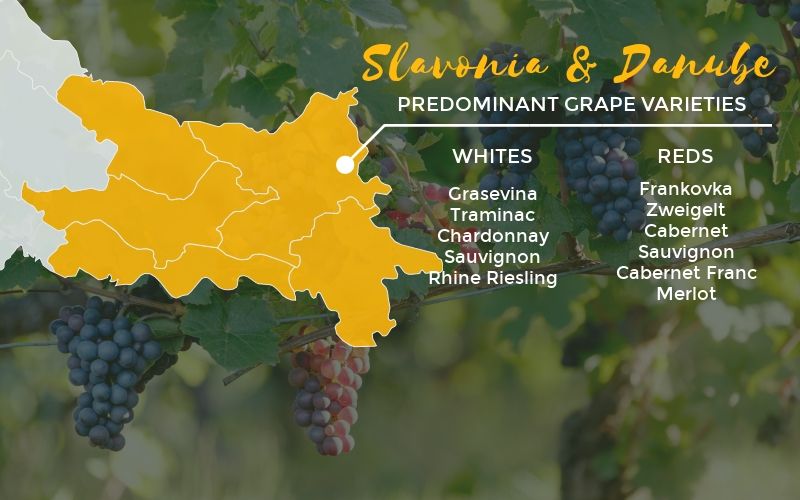
Depending on the terroir, Graševina wines can range from the delicate, refreshing styles found in western Slavonia to quite opulent, dry, fresh and mineral styles from central Slavonia, to mature, robust, full-bodied Graševina wines hailing from the Danube plains.
In addition to Graševina, the area around the eastern border of this region is also championing Chardonnay, Traminac (aka Gewürtztraminer), Rajnski Rizling (aka Rhine Riesling), and Sauvignon. As for the reds, Slavonia is mostly home to Frankovka (aka Blaufränkisch) and Zweigelt, but also Cabernet Sauvignon, Cabernet Franc, and Merlot.
Slavonia has a cold continental climate, so as a general rule, the vineyards in this region are dominated by white varieties that produce dry, fresh and aromatic wines. Also, the region is becoming recognized for its sweet icewines that can age for decades and are regarded as jewels of this region.
And apart from its wines, Slavonia is also known for the world-famous Slavonian oak which is used for making wine-aging barrels not just in Croatia but also in neighboring Italy.
Stay tuned for more related topics by following TCN's dedicated gourmet page.
Croatian Wine Regions: Croatian Uplands
January 7, 2019 — In the third article of the Croatian Wine Regions series, TCN unveils Croatian Uplands, the country's northernmost winemaking region.
Hrvatsko zagorje or Croatian uplands is most known for its indigenous white varieties Mirkovača, Moslavac, and Stara krapinska belina (lit. the old Belina of Krapina). The latter is one of the oldest varieties in the world and is considered to be the ancestor of numerous world-famous varieties like Chardonnay, Rhine Riesling, etc. In France and Germany, this Croatian variety is known as Gouais blanc and Heunisch weiss, respectively.
Other notable white wine varieties of Zagorje are Silvanac, Muškat, Pušipel, Kraljevina, and Škrlet, while international varieties include the aforementioned Chardonnay and Rhine Riesling, but also Sauvignon, Traminac (Gewürztraminer), Pinot blanc, and Pinot gris. The cultivation of red varieties in this area mostly comes down to Frankovka and Portugizac.
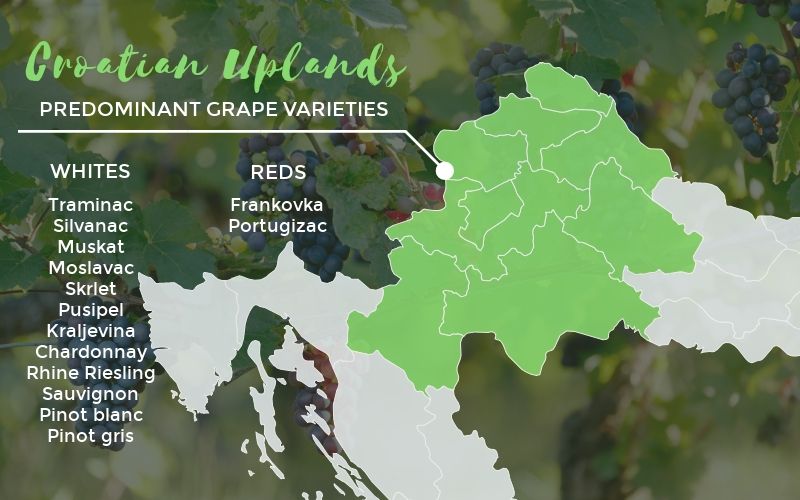
As the northernmost Croatian wine region, in recent years, Zagorje has been pioneering in the domestic production of icewines but the region is also gaining recognition as a producer of some of the finest sparkling wines.
In particular, the area of Pleševica hills is regarded as the next big thing in Croatian winemaking and is today one of the most important spots on the Croatian wine map. Though it has a continental climate, this small Uplands subregion gets a lot of sun and is producing mainly Chardonnay, Graševina, Pinot blanc, Traminac, Riesling and Portugizac.
For more related content on Croatian wine regions, make sure you're following TCN's gourmet page.
Croatian Wine Regions: Dalmatia
January 4, 2019 — In the second article of the Croatian Wine Regions series, TCN unveils Dalmatia, Croatia's southernmost region.
Archaeological evidence and grapevine seeds found in 1986 at an early-Illyrian gravesite in Površje near Zadar suggest that viticulture had been present in the region as early as 3,800 years ago. In fact, the entire history of Dalmatia is heavily linked to winegrowing as that was one of the key pillars of the region's economy.
However, the real development of viticulture started with the Greek colonies and their city-state settlements on the Adriatic. Back then, the polis of Issa on today's island of Vis as well as the polis of Pharos on today's Hvar were both already well-known for producing top-quality wines. Greek legacy in Dalmatia was later continued by the Romans who conquered the Illyrians and brought winemaking in the region to an enviable level.
What followed were centuries of political and economic turmoil, including several major agriculture crises, but fast forward to 21st century, the modern-day Dalmatia is once again producing top-quality wines and is mostly focused on championing the region's native varieties.
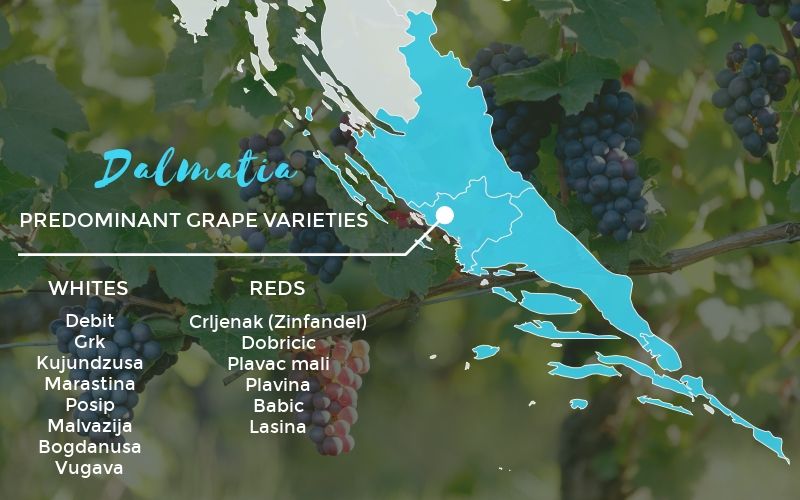
Dalmatia is today probably most known for being the homeland of the world-famous Zinfandel. Not so long ago, this robust red was in America considered to be native to California and recognized as a close relative to the Italian Primitivo, but as it turns out, both varieties are in fact genetically identical to an ancient Dalmatian variety called Kaštelanski crljenak (aka Tribidrag; Pribidrag), which was in 2002 confirmed by a DNA analysis.
But if they're all identical — you may ask — how can we know which variety is the ancestor? Well, the first written mention of the name Primitivo dates back to the year 1799, and Zinfandel was first mentioned in 1837, whereas the name Tribidrag dates back to the 15th century.
Etymologically, the word tribidrag is of Greek origin and roughly translates to "early maturation," just as the Italian name for this variety has its roots in Latin primativus, meaning the same — the first to ripen. On the other hand, the etymological origin of zinfandel remains a mystery.
It was also discovered that Crljenak and Dobričić were the parents of Plavac mali, one of Dalmatia's most widespread reds found mostly on the Pelješac peninsula and the islands of Brač, Hvar, Korčula, and Vis. This variety is particularly prized for its sturdiness and resistance to disease, so much so that the Dalmatians have an old saying that goes: "Praise every variety but plant Plavac mali."
Other notable Dalmatian red varieties include Plavina, Lasina, and Babić. The latter accounts for only about 1% of the production in Croatia, and the best site for this Dalmatian red is the UNESCO-listed Bucavac vineyard near Primošten.
As for the whites, Debit of Šibenik area is currently going through a renaissance and is gaining more and more recognition, but the king of Dalmatian white varieties is still Pošip, bar none. This is also the first Croatian variety with a protected geographical origin. Its natural habitat is the island of Korčula where Pošip originated through natural selection as a spontaneous crossbreed between two pre-domesticated vines, Bratkovina and Blatska zlatarica. Other notable Korčula varieties include Grk, Cetinka, and Maraština which is also widespread in other parts of Dalmatia.
Dubrovnik is most known for its Malvasia, though unlike the Istrian indigenous variety, Dubrovačka malvazija is in fact genetically identical to several Italian and Spanish varieties.
Stay tuned for more on Croatian wine regions by following TCN's dedicated gourmet page.
Croatian Wine Regions: Istria & Kvarner
January 3, 2019 — In the first article of the Croatian Wine Regions series, TCN unveils Istria and Kvarner, Croatia's westernmost region.
Istria is one of the oldest winegrowing regions in Europe, as the first vines were introduced to the region by the Greeks as early as the 6th century BCE. Today, with just a little over 6,000 hectares under vineyards, Istria carries the moniker "Croatian Tuscany" and is home to a diverse range of high-quality wines.
Wine production in Istria took a full turn in the early 1990s when new generations of winemakers started reinvigorating their family vineyards. Liberated from the socialist-era command economy in which winegrowers were basically coerced to sell their grapes to the state-controlled cooperatives, these new generations of independent winemakers could now focus on quality rather than quantity.
Blessed with the region's exceptional terroir, Istrian producers are nowadays equally championing indigenous as well as international varieties.
In terms of climate, Istria gets the best of both the Mediterranean and mild continental climate. Think palm trees covered in snow — that's Istrian peninsula in a nutshell. While summer heat is tempered by sea breezes from the Adriatic, another key factor is the closeness of the Dinaric Alps, and let's not forget to mention the heterogeneity of Istrian soil.
The terracotta-colored crljenica (red clay soil) is found in coastal areas; it is rich in iron and mainly reserved for growing red varieties, though it can also produce full-bodied and well-structured whites. The central part of the peninsula is known as the "grey Istria" because of its flysch soil (sedimentary rock with grey clay rich in limestone) which is most suitable for white varieties. And last but not least, the rolling hills of inland Istria are characterized by even more limestone, and vineyards in these areas produce aromatic, elegant wines with higher levels of acidity.
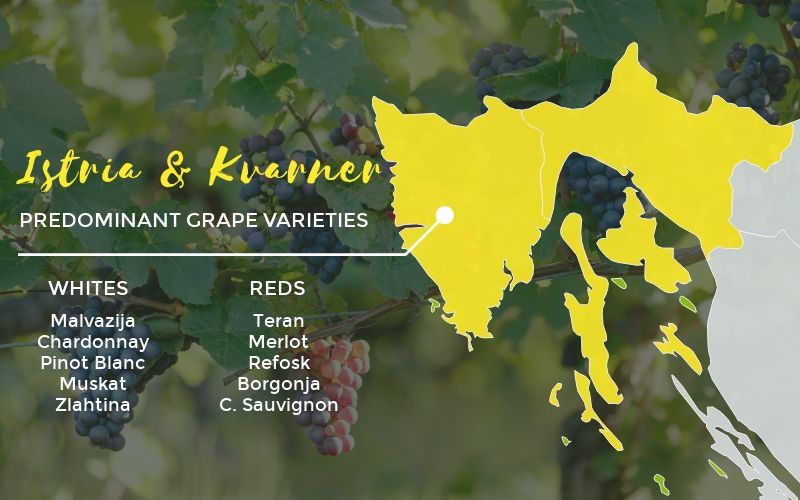
Malvazija Istarska represents 70% of the entire production; it is the most widespread white grape variety in the region, followed by Chardonnay. Other whites include Muškat, Pinot Blanc, Pinot Grigio, and Sauvignon Blanc. As for the reds, if Malvazija is the queen of whites, then Teran is the absolute king of Istrian red wines, although Merlot is actually the most widespread variety. Some critics have even said that Istria could quite possibly be the world's second-best Merlot terroir after Bordeaux, its homeland. Other notable mentions include Refošk, Borgonja and Cabernet Sauvignon, but also Cabernet Franc, Hrvatica, Barbera, and Pinot Noir.
The neighboring Kvarner region, and in particular the island of Krk, are most notable for being home to Vrbnička Žlahtina. The name of this popular white grape variety comes from the fertile plains northwest from the town of Vrbnik, and the old Slavic word zlahten, which means "noble." Žlahtina is indigenous to Krk, and it is by far the island's most planted variety that produces light, fruity wines which are best consumed young.
Stay tuned for more on Croatian wine regions by following TCN's dedicated gourmet page.



